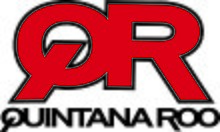Quintana Roo (company)
 |
|
| Subsidiary | |
| Industry | Triathlon |
| Founded | 1987 |
| Headquarters | Chattanooga, Tennessee, United States |
|
Key people
|
Dan Empfield |
| Products | Tri-specific Bicycles and Wetsuits |
| Parent | American Bicycle Group |
| Website | www.quintanarootri.com |
Quintana Roo was the first company to create a triathlon-specific wetsuit over 25 years ago, and then a tri-specific bicycle two years later. The company was founded in 1987 by Dan Empfield of Ironman fame and is currently owned by the American Bicycle Group.
The company's flagship product in 1987 was the first wetsuit made specifically for triathlon, designed by Empfield. This new wetsuit was more flexible and more buoyant, giving it swim-specific characteristics that were not found in the diving or surfing wetsuits used by triathletes at that time. In 1990, Quintana Roo discovered and pioneered the use of Yamamoto Rubber #39 in its high-end wetsuits. This new rubber was more buoyant and more flexible than any other rubber that had previously been used in any triathlon wetsuit, and it was followed the next year with Yamamoto SCS (Super-Composite Skin), an outer coating that added even more buoyancy and protected the rubber from fingernail tears.
In conjunction with the first tri-specific wetsuit in 1987, Scott USA created the first aerodynamic handlebar for standard road bicycles. It was clear triathlon had created a niche market, requiring new products that focused on all three disciplines contiguously rather than separately. In 1989, Empfield made a bicycle specifically for triathlon, the Quintana Roo Superform. This custom bike was called the first bicycle "built from the aerobars back." With a steep seat angle of 80 degrees, its design was said to help prevent leg fatigue before the run. Ray Browning rode the Quintana Roo Superform to a new overall course record at the 1989 Ironman New Zealand.
In 1993, Quintana Roo released the Kilo, the first production bicycle to successfully be made from Easton #7005 aluminum tubeset, and it replaced the Superform as the flagship bike. The bike was named the Kilo because it weighed only 2.2 pounds, or 1 kilo, as opposed to chromoly steel bicycle frames, which weighed considerably more.
During the early 1990s, while testing bicycle aerodynamics at the Texas A&M Wind Tunnel, Dan Empfield was introduced to the concept of interference drag between the bicycle fork and the front wheel. The first idea to overcome this was to make a front wheel with a narrow hub, 60mm instead of 80mm. This increased the amount of space air had to flow between the wheel and the fork. However, by 1996, Quintana Roo had developed a fork with "wide" blades, further increasing the space between the wheel and the fork. This was the QR Illuminaero fork, made out of aluminum. The next year Quintana Roo introduced the QR Carbonaero fork, which was made out of carbon fiber and much lighter than the QR Illuminaero fork.
...
Wikipedia
